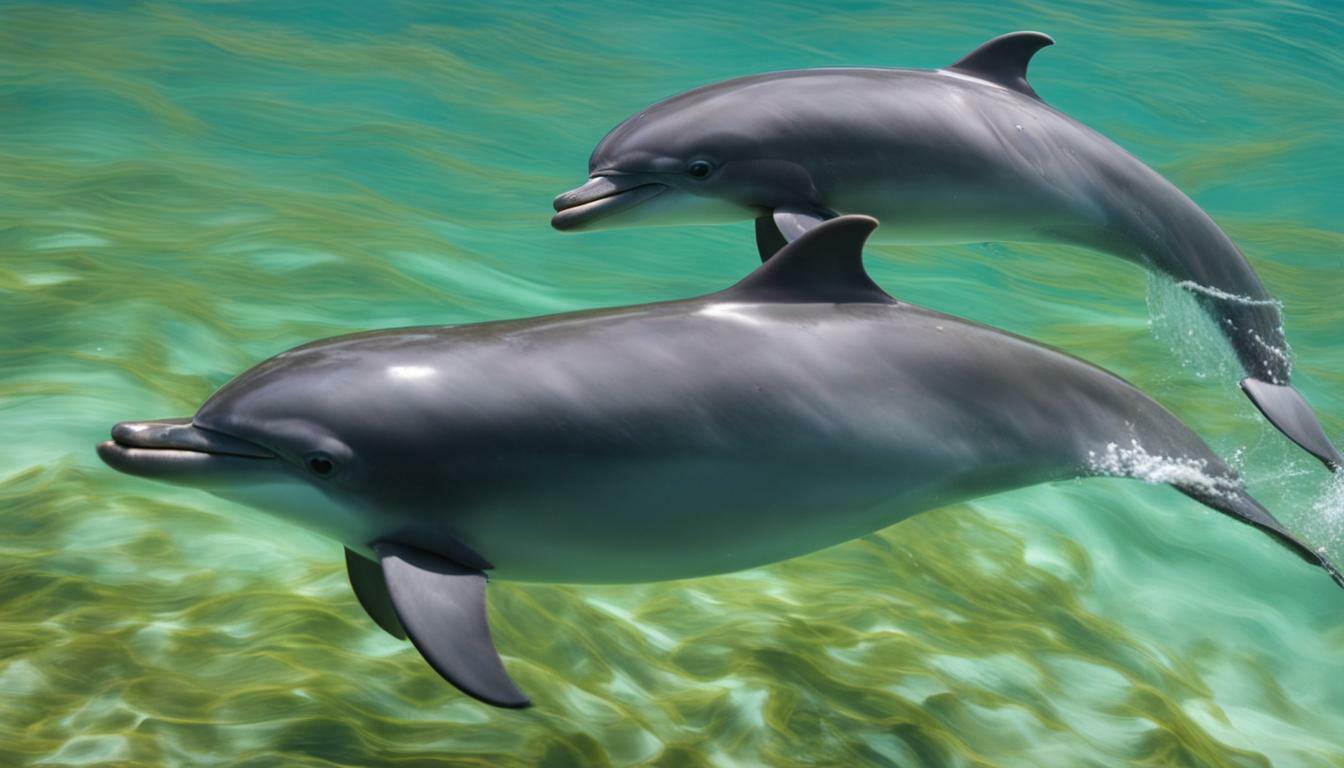Dolphins have a unique reproductive cycle and engage in fascinating mating behavior. From their indiscriminate amorous behavior to their complex social structures, these marine mammals captivate researchers and nature enthusiasts alike.
Unlike many other animals, dolphins do not have a specific mating season. They are capable of mating year-round, making their reproductive cycle a constant and intriguing phenomenon.
Male dolphins typically become sexually mature between 8 to 12 years old, while females reach sexual maturity at around 5 to 10 years old. This difference in maturity age leads to interesting dynamics within dolphin communities.
When it comes to mating, dolphins engage in extensive foreplay, with approximately 90% of their mating activity dedicated to this activity. Actual intercourse, however, takes only a matter of seconds.
What sets dolphins apart is their indiscriminate sexual behavior. They engage in sexual activities with both opposite and same genders, displaying a fluidity that challenges traditional notions of mating behavior.
In addition to foreplay and intercourse, dolphins exhibit other intriguing sexual behaviors. They are known to engage in masturbation, a behavior that provides them with pleasure and a means of bonding with other dolphins. Dolphins also utilize echolocation for pleasure, further expanding their repertoire of sexual behaviors.
Female dolphins play a key role in reproduction, as they possess a bicornate uterus and their cervix contains annular folds for protection. Dolphin births can occur in any month of the year, and females typically ovulate 2-7 times annually.
Mating behaviors in dolphins go beyond the act itself. Dolphins engage in courtship displays, which can lead to the development of breeding pairs and enduring pair bonds. These displays, along with recreational behaviors such as playing with objects and engaging in social play, contribute to the complexity of their mating habits.
Dolphins also exhibit diverse social structures within their communities. Various pod formations, including maternal pods, juvenile pods, bachelor pods, and super-pods, provide insights into their social dynamics. Female dolphins take on the primary role in calf rearing, while males do not partake in raising their young.
Furthermore, dolphins have been observed engaging in homosexual behavior and coercion during mating, further highlighting the multifaceted nature of their reproductive and mating behaviors.
In conclusion, dolphins possess a remarkable reproductive cycle and engage in a wide range of fascinating mating behaviors. Their unique traits, social structures, and diverse sexual behaviors make them a captivating subject of study and a true wonder of the animal kingdom.
Dolphins Reproductive Cycle
Dolphins do not have a specific mating season and are capable of reproducing year-round. Males typically become sexually mature between 8 to 12 years old, while females reach sexual maturity at around 5 to 10 years old. When it comes to their reproductive cycle, dolphins engage in foreplay for approximately 90% of their mating activity. The actual act of intercourse, however, takes only a few seconds.
Dolphins are known for their indiscriminate amorous behavior, as they engage in sexual interactions with both opposite and same genders. They also display interesting sexual behaviors such as masturbation, which contributes to their complex reproductive habits. Fascinatingly, dolphins have been observed using echolocation for pleasure.
“Male dolphins have their penis and testicles packed inside their body to maintain a streamlined shape, while female dolphins have a bicornate uterus and the cervix contains annular folds for protection.”
Dolphin births can occur in any month of the year, as females typically ovulate 2-7 times annually. The reproductive behavior of dolphins includes intriguing courtship displays, often leading to the formation of breeding pairs and enduring pair bonds. Additionally, dolphins engage in recreational behaviors such as playing with objects and social play, which further add to their complex mating habits. Their social structures also involve the formation of various pod formations, including maternal pods, juvenile pods, bachelor pods, and super-pods.
Summary
In summary, dolphins do not have a specific breeding season and are capable of reproducing throughout the year. Males become sexually mature between 8 to 12 years old, while females reach maturity at around 5 to 10 years old. Dolphins engage in foreplay for the majority of their mating activity and display amorous behavior towards both opposite and same genders. They also indulge in unique sexual behaviors such as masturbation and utilize echolocation for pleasure. The mode of reproduction in dolphins involves courtship displays, formation of breeding pairs, and enduring pair bonds. Additionally, dolphins exhibit a range of social structures and engage in various recreational behaviors. Female dolphins play a prominent role in calf rearing while males do not participate in raising their young. Homosexual behavior and coercion during mating are also observed among dolphins, further highlighting the complexity of their reproductive behaviors.
| Dolphin Reproductive Cycle | |
|---|---|
| Reproductive Season | Year-round |
| Sexual Maturity | Males: 8-12 years old Females: 5-10 years old |
| Foreplay Duration | Approximately 90% of mating activity |
| Actual Intercourse Duration | A few seconds |
| Sexual Behaviors | Indiscriminate amorous behavior towards both opposite and same genders, masturbation, pleasure-seeking through echolocation |
| Reproductive Anatomy | Male dolphins have their penis and testicles packed inside their body to maintain a streamlined shape. Female dolphins have a bicornate uterus and the cervix contains annular folds for protection. |
| Births | Can occur in any month of the year |
| Ovulation | 2-7 times per year |
| Reproductive Behavior | Courtship displays, formation of breeding pairs, enduring pair bonds |
| Social Structures | Pod formations (maternal pods, juvenile pods, bachelor pods, super-pods) |
| Parental Care | Female dolphins play a primary role in calf rearing, while males do not participate in raising their young |
| Additional Behaviors | Recreational behaviors, including playing with objects and engaging in social play; occurrence of homosexual behavior and coercion during mating |
Dolphin Mating Behavior
Dolphins engage in unique mating behaviors, including extensive foreplay and sexual activities with both opposite and same genders. Their mating rituals involve an intriguing combination of playfulness and complexity. In fact, dolphins spend approximately 90% of their mating activity engaged in foreplay, using a variety of techniques to stimulate each other before actual intercourse takes place, which lasts only a few seconds.
These intelligent creatures exhibit a diverse range of sexual behaviors, including interactions with members of the same gender. Dolphins are known to engage in same-sex activities, including mounting and genital contact, which highlights their flexible sexual nature. Additionally, dolphins have been observed engaging in masturbation and have even been known to use echolocation for pleasure. This aspect of their behavior showcases the depth of their sexual exploration and adds to the complexity of their mating rituals.
When it comes to dolphin reproduction, females have a bicornate uterus and the cervix contains annular folds for protection. Dolphin births can occur in any month of the year, and females typically ovulate 2-7 times a year. However, males play no role in the rearing of their young, with females taking on the primary responsibility. This is consistent with their social structure, where females play a significant role in pod dynamics and calf nurturing.
Complex Social Structures
In addition to their intricate mating behaviors, dolphins exhibit complex social structures. They form various pod formations, including maternal pods, juvenile pods, bachelor pods, and super-pods, which are large gatherings of multiple pods. These social structures provide dolphins with opportunities for socializing, playing, and learning from each other. They engage in recreational behaviors such as playing with objects and participating in social play, further enriching their relationships within the pod.
Furthermore, dolphins showcase courtship displays, which can lead to the formation of breeding pairs and enduring pair bonds. These courtship behaviors involve intricate movements, vocalizations, and physical displays intended to attract a suitable mate. It is interesting to note that dolphins also exhibit homosexual behavior and coercion during mating, reflecting the complexity and diversity of their mating strategies.
Table: Mating Behaviors of Dolphins
| Mating Behavior | Description |
|---|---|
| Foreplay | Dolphins engage in extensive foreplay, which constitutes around 90% of their mating activity. |
| Masturbation | Dolphins exhibit self-pleasure behaviors, including masturbation, as a part of their mating repertoire. |
| Same-Sex Activities | Dolphins engage in sexual behaviors with members of the same gender, including mounting and genital contact. |
| Use of Echolocation | Dolphins have been observed using echolocation for pleasure, enhancing their sexual experiences. |
| Breeding Pairs | Courtship displays can lead to the formation of breeding pairs and enduring pair bonds. |
| Pod Formations | Dolphins form various pod structures, including maternal pods, juvenile pods, bachelor pods, and super-pods. |
In conclusion, dolphins exhibit a wide range of unique mating behaviors, including extensive foreplay, sexual activities with both opposite and same genders, and the use of echolocation for pleasure. Their complex social structures and courtship displays add depth to their mating rituals. From masturbation to same-sex interactions, dolphins showcase a diverse and fascinating repertoire of sexual behaviors. These behaviors, combined with intricate pod dynamics and reproductive processes, contribute to the fascinating world of dolphin mating behavior.
Dolphin Reproduction and Births
Dolphin reproduction involves the complex process of giving birth and the primary role of female dolphins in raising their young. Dolphins have no specific mating season and mate year-round, allowing for a continuous cycle of reproduction. Male dolphins become sexually mature between 8 to 12 years old, while females become sexually mature at around 5 to 10 years old. This maturity age range varies among different dolphin species.
During the mating process, dolphins engage in foreplay for about 90% of their mating activity. The actual intercourse itself takes only seconds. Dolphins are indiscriminately amorous and engage in sexual behaviors with both opposite and same genders. In addition to sexual activities, dolphins also engage in masturbation and use echolocation for pleasure.
Female dolphins possess a bicornate uterus, where the cervix contains annular folds for protection. This specialized reproductive system ensures the successful development and birth of dolphin calves. Dolphin births can occur in any month of the year, and females typically ovulate 2-7 times a year. Although the gestation period varies depending on the species, it generally lasts for around 11 to 12 months.
| Dolphin Reproduction Facts | |
|---|---|
| Reproductive Behavior | – Males become sexually mature between 8 to 12 years old – Females become sexually mature at around 5 to 10 years old – Dolphins mate year-round, with no specific mating season |
| Mating Habits | – Dolphins engage in foreplay for about 90% of their mating activity – Actual intercourse takes only seconds – Dolphins engage in sexual behaviors with both opposite and same genders |
| Reproductive Cycle | – Female dolphins have a bicornate uterus with annular folds in the cervix – Dolphin births can occur in any month of the year – Females typically ovulate 2-7 times a year |
Within dolphin societies, complex mating behaviors and social structures can be observed. Courtship displays are common, serving as a prelude to mating. These displays can lead to the development of breeding pairs and enduring pair bonds. Recreational behaviors, such as playing with objects and engaging in social play, are also common among dolphins.
Dolphins form various pod structures, including maternal pods, juvenile pods, bachelor pods, and super-pods. In these social groupings, female dolphins play a primary role in calf rearing, while males do not participate in raising their young. Homosexual behavior has been observed among dolphins, as well as instances of coercion during mating. This diverse range of mating behaviors and social structures adds to the complexity of dolphin reproduction.
Summary
- Male dolphins become sexually mature between 8 to 12 years old, while females become sexually mature around 5 to 10 years old.
- Dolphins engage in foreplay for about 90% of their mating activity, with actual intercourse lasting only seconds.
- Female dolphins possess a bicornate uterus with annular folds in the cervix, facilitating successful reproduction and childbirth.
- Dolphin births can occur in any month of the year, and females typically ovulate 2-7 times a year.
- Mating behaviors include courtship displays, the development of breeding pairs, and enduring pair bonds.
- Dolphins exhibit complex social structures, including pod formations and various specialized pods.
- Female dolphins play a primary role in calf rearing, while males do not participate in raising their young.
- Dolphins engage in recreational behaviors and exhibit diverse mating behaviors, including homosexual behavior and instances of coercion.
Complex Mating Behaviors and Social Structures
Dolphins exhibit a range of complex mating behaviors and social structures, including courtship displays, pod formations, and recreational behaviors. These fascinating creatures engage in elaborate courtship rituals, using various displays to attract potential mates. These displays can involve vocalizations, body movements, and impressive acrobatic feats, showcasing their agility and strength.
Once courtship is successful, dolphins form breeding pairs and may develop enduring pair bonds. These bonds are characterized by mutual cooperation and companionship, with the pair displaying synchronized swimming and close physical contact. Dolphins also engage in recreational behaviors, such as playing with objects and engaging in social play. These activities serve to strengthen social bonds within the pod and provide opportunities for learning and development.
Dolphins exist within a hierarchical social structure, with various pod formations observed. These structures include maternal pods, which consist of females and their offspring, juvenile pods, bachelor pods, and super-pods. These social structures allow for cooperative hunting, protection against predators, and the sharing of knowledge and resources. Within these pods, females play a primary role in calf rearing, providing care and guidance to their young. In contrast, male dolphins do not participate in raising their offspring.
| Pod Structures | Description |
|---|---|
| Maternal Pods | Consist of females and their offspring, providing support and protection for the calves. |
| Juvenile Pods | Composed of young dolphins who engage in playful activities and learn vital skills from one another. |
| Bachelor Pods | Consist of young male dolphins that have not yet formed breeding pairs. They socialize and learn from one another. |
| Super-pods | Occur when multiple pods come together, forming large groups that can consist of hundreds or even thousands of dolphins. These gatherings provide opportunities for social interactions, mating, and hunting on a grand scale. |
It is important to note that dolphins also display homosexuality and coercion during mating. Homosexual behavior, observed in both males and females, may serve various purposes such as social bonding, playfulness, and dominance display. Additionally, coercion during mating has been observed in certain instances, with males forcefully pursuing females for mating. These complex behaviors further add to the diversity and intrigue of dolphin mating and social interactions.
Do Dolphins’ Reproductive Cycle and Mating Behavior Affect Their Migration Patterns?
Dolphins’ reproductive cycle and mating behavior greatly impact their migration patterns. These fascinating creatures exhibit complex social structures and engage in long-distance movements to find suitable mates. By understanding dolphin migration patterns, researchers can gain insights into their mating strategies and reproductive success.
Do Dolphins Experience Headaches or Concussions?
Dolphins, unlike woodpeckers and their resistance to concussions, do not experience headaches or concussions. With their thick skulls and specialized anatomical features, dolphins have adapted to a life underwater, which minimizes the risk of head injuries. Their unique body structure and sonar system enable them to navigate and interact in their aquatic environment without the need to withstand impact-related trauma.
What are the similarities and differences between the reproductive cycles and mating behaviors of lions and dolphins?
The lions mating and reproduction cycle and that of dolphins exhibit both similarities and differences. Both species have distinct reproductive cycles, with lions having an estrous cycle and dolphins having a reproductive season. However, lions engage in polygamous mating behaviors while dolphins are known for their promiscuous tendencies. These variances highlight the fascinating diversity in the reproductive strategies of these two majestic creatures.
Conclusion
Understanding the reproductive cycle and mating behavior of dolphins provides fascinating insights into their lives and interactions in the marine environment. Dolphins have no specific mating season and mate year-round. Males become sexually mature between 8 to 12 years old, while females become sexually mature at around 5 to 10 years old. Dolphins engage in foreplay for about 90% of their mating activity, with actual intercourse only taking seconds.
Dolphins are indiscriminately amorous and engage in sexual behaviors with both opposite and same genders. They also engage in masturbation and use echolocation for pleasure. Male dolphins have their penis and testicles packed inside their body to maintain a streamlined shape. Female dolphins have a bicornate uterus and the cervix contains annular folds for protection. Dolphin births can occur in any month of the year, and females typically ovulate 2-7 times a year.
Mating behaviors of dolphins include courtship displays, which can lead to the development of breeding pairs and enduring pair bonds. Dolphins also engage in recreational behaviors such as playing with objects and engaging in social play. They exhibit complex social structures, including pod formations, maternal pods, juvenile pods, bachelor pods, and super-pods. Female dolphins play a primary role in calf rearing, while males do not participate in raising their young. Dolphins also engage in homosexual behavior and coercion during mating.
In conclusion, dolphins demonstrate a range of complex behaviors related to mating and reproduction. The lack of a specific mating season, the extensive use of foreplay, and the diverse sexual behaviors highlight the unique nature of dolphin mating. Additionally, the formation of various social structures and the involvement of female dolphins in calf rearing contribute to the intricate dynamics within dolphin communities. Exploring these aspects of dolphin life provides a deeper understanding of their fascinating existence in the marine world.










